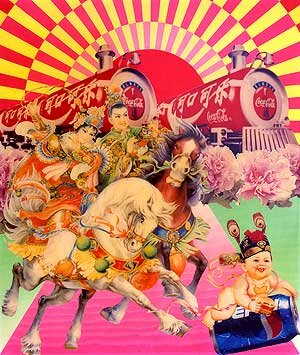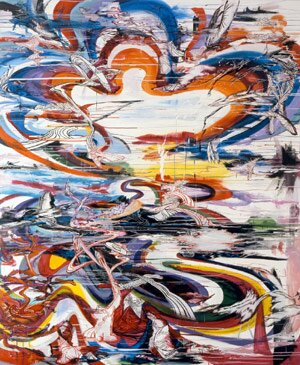RED HOTonomics
Posted by ben on 21 Sep 2007 at 03:14 pm | Tagged as: responses/reviews
 The MFAH’s new exhibit of Asian art, RED HOT, is essentially a study in economics. From the collector-as-investor approach of the Chaney family (from whose collection the show is drawn), to the collector-as-curator approach of MFAH, to the capitalism-comes-to-the-east themes of much of the work, it all boils down to a commentary on the flow of money. And of course, the discussion is framed by those who stand to make the most money out of the show.
The MFAH’s new exhibit of Asian art, RED HOT, is essentially a study in economics. From the collector-as-investor approach of the Chaney family (from whose collection the show is drawn), to the collector-as-curator approach of MFAH, to the capitalism-comes-to-the-east themes of much of the work, it all boils down to a commentary on the flow of money. And of course, the discussion is framed by those who stand to make the most money out of the show.
The Beijing-based Luo Brothers are prominently displayed with their Welcome to the World’s Most Famous Brands series (shown to the left), an exploration of the clash of western brands such as Coca-Cola with traditional Chinese iconography. The Luo Brothers use traditional craft techniques such as wood carving, but finish the work in a way that makes it look almost plastic.
Many of the Japanese artists have thrown themselves into capitalism and consumer culture to a degree rarely seen even in the United States. Artists working for the Japanese art corporation Kaikai Kiki are prominently featured, with two large works by Mr. and two by Chiho Aoshima. Aoshima joined Kaikai Kiki with a degree in ecomonics under her belt, but no formal art training. Both artists explore the fantasy worlds of graphic novels and anime, with a focus on the fragmented, shifting context of a culture that thrives on a never-ending stream of new information. In Mr’s large painting of the Akihabara district in Tokyo, for instance, a dizzying array of costumed characters run through the district, many carrying little worlds in their thought bubbles, creating a chaotic system of divergent contexts. Tellingly, next to the Kaikai Kiki work, a display of Japanese consumer fads such as Speed Racer and Hello Kitty toys gives the ignorant viewer proper context.
 Even when works in the show deal with more universal issues, such as Do Ho Suh’s Karma or Suling Wang’s Open Paths of Origin (shown to the left), the context of the exhibit leads consideration of this work into economic themes. As I discussed Do Ho Suh’s Karma (installed next to the Kaikai Kiki work) with a friend, the conversation kept coming back to economic systems, although the work on its own addresses broader issues of the relationship between the individual and society. Although the concept of karma is, I suppose, a kind of economic system, I think the placement of the work next to Mr’s Penyo-Henyo encourages a narrow reading.
Even when works in the show deal with more universal issues, such as Do Ho Suh’s Karma or Suling Wang’s Open Paths of Origin (shown to the left), the context of the exhibit leads consideration of this work into economic themes. As I discussed Do Ho Suh’s Karma (installed next to the Kaikai Kiki work) with a friend, the conversation kept coming back to economic systems, although the work on its own addresses broader issues of the relationship between the individual and society. Although the concept of karma is, I suppose, a kind of economic system, I think the placement of the work next to Mr’s Penyo-Henyo encourages a narrow reading.
Of course, there’s plenty of interesting work I’m not able to touch on here, and the exhibit is very dense, even cramped. The pieces in the RED HOT exhibit do address important cultural issues from a range of viewpoints, and much of the work is strong; but I have to wonder whether the economic framework set up by the collectors, who are the de facto curators, gives us a distorted view of what is happening in the Asian art world. Or, alternatively, whether it gives us an accurate view of the impact that Western collectors have already made on the art scene in Eastern Asia. In which case, we must wonder to what extent it really is a distinct scene.
And with that Heisenbergian conundrum, I conclude my thoughts on RED HOT.
“What more can we say? Isn’t it a lovely thing to make a large army appear, by using mirrors, when you need only have a single man? Or to make a long row of columns, and a beautifully ordered building, by placing but a single column between two opposite mirrors? Isn’t this to become rich at very little expense – at least in appearance?”-Niceron
Hey jackass with a book of quotes and a beaver shaped bong, go outside and walk your dog or collect shiny things. Do us all a favor and take a long quote riddled walk off a short poetic pier.
“Just like the white wing dove, sing a song sounds like she’s singing, whoo baby, whoooo” – STEVIE NICKS.
“
Postscript: Don’t make the Retired Col. [read: Kernel] angry. We do not need to rekindle the flames of World War II.
“CinemaScope is fine for snakes and coffins, but not for people”-Fritz Lang
fritz lang is dead, and so is cinemascope. connection?
“This heaven will pass away, and the one above it will pass away.
The dead are not alive, and the living will not die. During the days when you ate what is dead, you made it come alive.
When you are in the light, what will you do? On the day when you were one, you became two.
But when you become two, what will you do?”-Jesus (Gospel of Thomas )
zzzzzzzzzzzzzzzzzz.
“There is between sleep and us something like a pact, a treaty with no secret clauses, and according to this convention it is agreed that, far from being a dangerous, bewitching force, sleep will become domesticated and serve as an instrument of our power to act. We surrender to sleep, but in the way that the master entrusts himself to the slave who serves him.”-Maurice Blanchot
“In 1910, Japan forced Korea to sign the Japan-Korea Annexation Treaty, although it was executed by Korean ministers and advisors as full-powered attorney assigned by Sunjong of Korean Empire.[9] The treaty was never ratified by the Korean Emperor and was missing the Korean Imperial seal, thus making it invalid. Korean resistance to the brutal [10][11][12] Japanese occupation was manifested in the nonviolent March 1st Movement of 1919, where 7,000 demonstrators were killed by Japanese police and military.[13] Thereafter the Korean liberation movement was largely active in neighboring Manchuria and Siberia.
Over five million Koreans were conscripted for labor beginning in 1939[14] and tens of thousands of men[15] were conscripted into Japan’s military. Approximately 200,000 girls and women,[16] mostly from Korea and China, were pressed into work as sex slaves,[17] euphemistically called “comfort women”.[18]
I want a beaver shaped bong.
“There is considerable discrimination in Japan against the hibakusha. It is frequently extended toward their children as well: socially as well as economically. “Not only hibakusha, but their children, are refused employment,” says Mr. Kito. “There are many among them who do not want it known that they are hibakusha.”-Studs Terkel